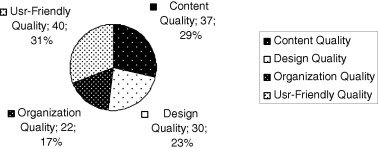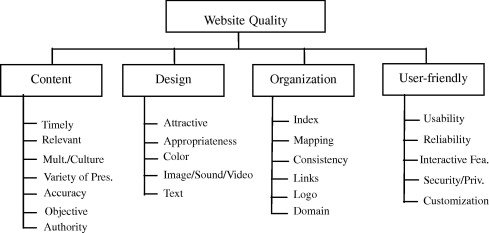This article reviewed the latest methods of assessment criteria that have been used in a variety of e-business services. In addition, it offers the general criteria for assessing the quality of any website, regardless of the type of services it offers. Dimensions of the criteria of content quality, design quality, organization quality and user-friendly quality. These dimensions, together with their indicators and comprehensive checklist of web designers and developers to create high-quality websites can be used to improve electronic services, and then the image of any organization on the Internet.
Keywords: e-commerce, e-services, website criteria assessment web site, the quality of the website
Introduction
Since the introduction of the first electronic web service in the mid-nineties of the last century, electronic services have spread across the globe in a variety of forms, changing the face of many business sectors. The new electronic revolution is not only driving the global economy, but also the transformation of society in the economy based on knowledge in the world. Over the past few years, the Internet has shown rapid growth in terms of sales volume of trade, which led to a new definition of almost all aspects of the business. Deploying the latest information and communication technologies has allowed firms to provide services of higher quality, lower prices for customers, as well as an increase in business profits. In addition, the new technology created new trends in business and production of a new era in the field of business, finance and economics.
E-government website forms a significant part of the scope of the government in the developed countries. It offers services to people in the pre-context of information technology, and new public management. Quality assurance through the website assessment stems from the fact that e-government website is the most important channel for the delivery of public services, as well as a citizen of the interaction of the government. In addition, the need to justify the public investment that makes possible web service delivery is one more reason to ensure quality of the site.
There are many categories of e-business; such as Business to Business (B2B), business to consumer (B2C), consumer to business (C2B) and consumer-to-consumer (C2C). E-business and e-commerce, as a rule, are used interchangeably leading to policy incoherence.
In recent years we have seen the spread of electronic sites with a huge amount of information, either with high quality or low quality as well as sites that are directly misleading number of websites has grown from 17 million in mid-2000 to 65 million in mid-2005, the explosion of the web has determined the need to measure the criteria for assessing the aspects relating to quality by using, for example, ease of use and availability of web applications. The aim is to make the site useful profitable user links, and reachable. Awareness of quality problems in recent years has affected all industrial sectors. The organization with a website that is difficult to use and interact with them gives a bad image on the Internet and weakens the position of the organization. Therefore, it is important for any organization to be able to assess the quality of their services e-commerce to improve their offerings over time and benchmark against competitors and best practices in any industry.
Basic information for visitors who do not always pay attention to usability, accessibility and content management of the site. For example, what does the government information services and e-government websites is not successful access by the users; especially for persons with disabilities. It is often the case for people to visit a website that is poorly structured, difficult to navigate and unfriendly to readers. Some sites take a long time to download content that makes people become impatient and leave. These sites are often developed by people who have an idea that the quality of the site is the one that shows the latest multimedia and animation effects
Previous work
Since the dependence of the increase in Web services, the need to assess the quality of performance from the web site and increases success. Sites are of great importance; They were a constant concern of research in various fields, and they have been extensively studied in the literature of e-commerce. Despite the fact that there has been considerable research to support e-commerce, many existing empirical studies have focused on the quality of websites, mainly exploratory in nature. Most current research or dealing with a limited number of quality factors or directed to a particular Web service. Thus, while it should be a substantial number and variety of factors related to the success of the web site, there are few studies on the combination of these factors and services. Recently, studies and research accumulate, including different models and / or a framework for assessing the quality and efficiency of websites. We classified the previous studies that examined the dimensions of quality Website, depending on the type of service that offers Website; such as business and commercial, educational, banking, government and others. This section provides a brief overview of previous studies, depending on the service website.
Discussion and Analysis
The aim of this study is to develop a theoretical, comprehensive and measurable basis for assessing the quality of websites in order to provide straight forward criteria to encourage more efficient web design and its implementation. In addition, we aim to develop a framework that is capable of reliable applications on a wide range of websites, regardless of the services they provide. multi-phase approach was adopted by A, it includes a wide range of literature review, an overview of the leading sites, identification of success factors from research and industry literature, comparing factors from published studies scoring industry, as well as using its own experience in this field. Our process is overlaid with industry and research in order to identify the quality factors in order to achieve the purposes of this study.
After a thorough and comprehensive review of the various valuation methods and their elements, which have been used in a variety of services through the Internet, we offer criteria 4-dimensions, which are comprehensive and include all previous dimensions and elements to be used as the common criteria to evaluate all kinds of sites. Dimensions of the proposed criteria for quality of content, design quality, organization quality and user-friendly quality. In order to investigate how our proposed criteria have been used in previous studies, we have re-arranged every element of each dimension of the previous work to be under one of the four new measurements. The result of the size of the permutation of the previous work in the proposed criteria 4 dimensions shown in Fig. 1.

Fig. 1. Overall dimensions
We have summarized the overall dimensions of quality according to a service that offers Web site. Overall dimensions, which have been used in the evaluation of e-business and e-commerce sites have focused on the currency, accuracy, comprehensive and value-added content, ease of use, reliability, availability of the necessary information, download speed setting, effective internal search, a variety of services and support customers, security and confidentiality in all types of operations, a logical grouping of elements of the website, as well as an attractive design that will attract users and encourage him / her to spend more time on the website.
Overall dimensions, which have been used to assess the quality of educational websites focused on the currency, accuracy, and comprehensibility of information, ease of use, clear layout of websites, as well as an attractive design. Overall dimensions, which have been used to assess the quality of banking sites focused on ease of use, customization, internal search function, the security of transactions, aesthetic effects, and useful interaction between users and Website to get instant feedback from the user web site. Overall dimensions, which have been used to evaluate government websites as a quick response time, up to date, accurate information, an effective search tool, it is easy to understand and secure transactions. Overall dimensions, which have been used to assess the quality of auctions and e-shopping sites are the design, content, security, support, and ease of use.
The proposed structure
The proposed structure is trying to integrate the knowledge and experience from different sources, a number of background disciplines and empirical methods. The goal is to determine the characteristics and measurable indicators that currently make up a successful website. The feature set is designed to include the current view of a perfect website. The proposed system can be used for comparison between the quality of website to determine the path to improve the website, and to provide guidance for designers and developers to create new website.
After we looked at each evaluation criterion, we have added their performance in a suitable place proposed criteria 4 sizes, in addition to adding some indicators that we see them important from our own experience. Our criteria include all the main indicators of previous studies evaluating the quality of websites. Fig. 2 summarizes the hierarchy of the proposed framework.

Fig. 2. Hierarchy of the proposed system
Conclusions
In recent years, the Internet has shown rapid growth in terms of sales volume of trade, which led to a new definition of almost all aspects of the business. Deploying the latest information and communication technologies for production of a new era in the field of business, finance and economics. The Internet has created a new business environment is very different from anything that has been before. The explosion on the Internet identified the need to measure the criteria for evaluating aspects related to the quality of web-based applications. Awareness of quality problems affected all of the industrial sector in recent years, as an organization with a website that is difficult to use and interact with them gives a bad image on the Internet and weakens the position of the organization. Therefore, it is important for the organization to assess the service quality of e-commerce in order to improve its services for a long time and benchmark against competitors and best practices in any industry
References:
- Abanumy et al., 2005. A. Abanumy, A. Al-Badi, P. Mayhew. E-Government website accessibility: in-depth evaluation of Saudi Arabia and Oman. Electronic Journal of e-Government, 3 (3) (2005), pp. 99–106
- Barnes and Vidgen, 2001. Barnes, S., Vidgen, R. 2001. Assessing the quality of auction website. In: Proceedings of the 34th International Conference on System Sciences.
- Gledec, 2005. Gledec, G. 2005. Evaluating web site quality. In: Proceedings of the Seventh Internet Users Conference (CUC2005), Croatia.
- Granath, 2005. Granath, K. 2005. Evaluating web pages. Available at: http://www.lib.umt.edu/research/guide/int_evalweb.htm.
- H. Jati and D. Dominic, «Quality Evaluation of e-Government Website Using Web Diagnostic Tools: Asian Case», International Conference on Information Management and Engineering (ICIME), Kuala Lumpur, 3–5 April 2009, pp. 85–89.
- L. Hasan and E. Abuelrub, «Assessing the Quality of Websites», Applied Computing and Informatics, Vol. 9, No. 1, 2011, pp. 11–29. http://dx.doi.org/10.1016/j.aci.2009.03.001
- D. T. Green and J. M. Pearson, «Integrating Website Usability with the Electronic Commerce Acceptance Model», Behaviour & Information Technology, Vol. 30, No. 2, 2011, pp. 181–199. http://dx.doi.org/10.1080/01449291003793785
- Georgia Tech Research Institute, «Overview of State Accessibility Laws, Policies, Standards and Other Resources», 2012. http://accessibility.gtri.gatech.edu/sitid/stateLawAtGlance.php
- D. L. Baker, «Advancing E-Government Performance in the United States through Enhanced Usability Benchmarks», Government Information Quarterly, Vol. 26, No. 1, 2009, pp. 82–88. http://dx.doi.org/ 10.1016 / j.giq.2008.01.004







